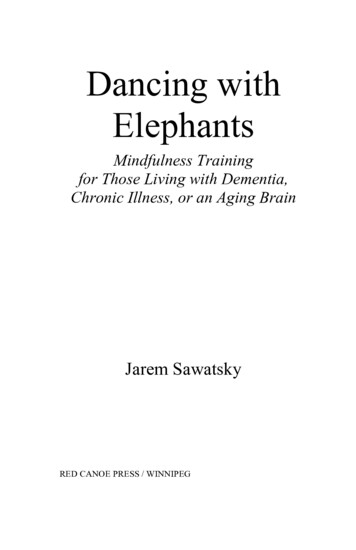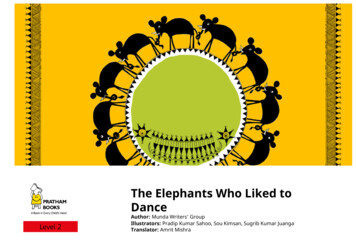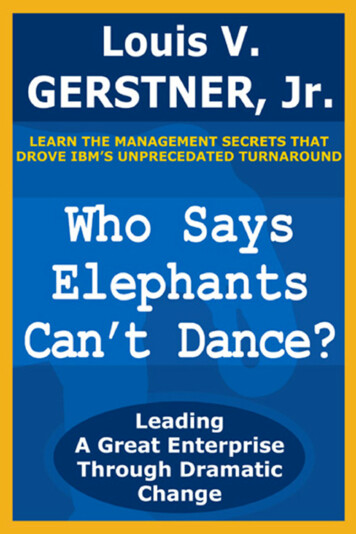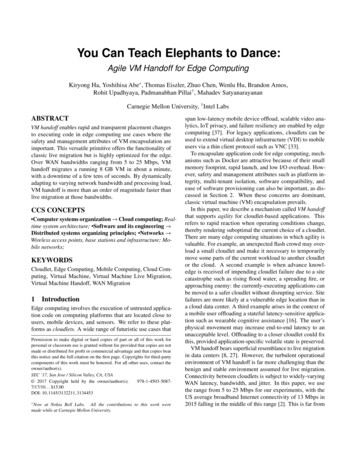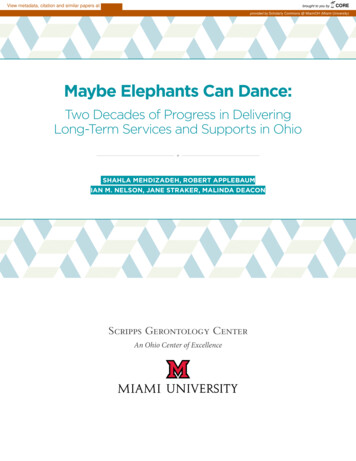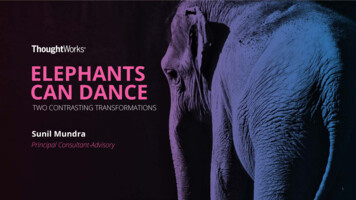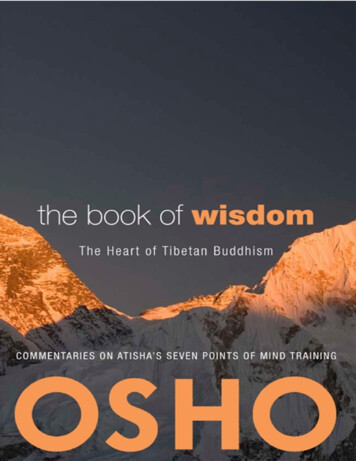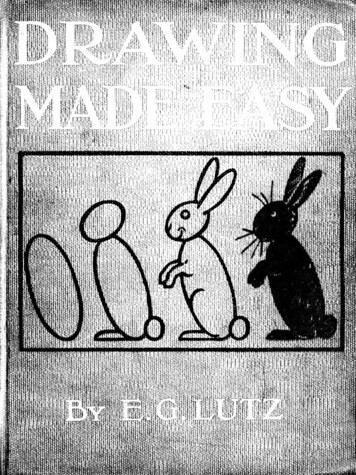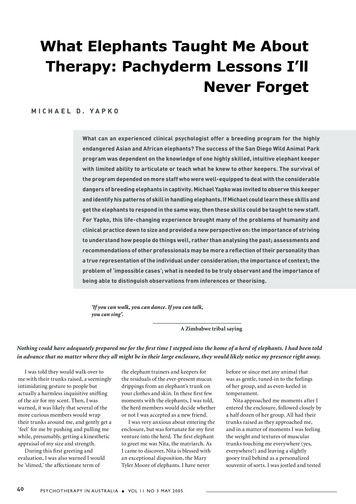
Transcription
What Elephants Taught Me AboutTherapy: Pachyderm Lessons I’llNever ForgetMICHAEL D. YAPKOWhat can an experienced clinical psychologist offer a breeding program for the highlyendangered Asian and African elephants? The success of the San Diego Wild Animal Parkprogram was dependent on the knowledge of one highly skilled, intuitive elephant keeperwith limited ability to articulate or teach what he knew to other keepers. The survival ofthe program depended on more staff who were well-equipped to deal with the considerabledangers of breeding elephants in captivity. Michael Yapko was invited to observe this keeperand identify his patterns of skill in handling elephants. If Michael could learn these skills andget the elephants to respond in the same way, then these skills could be taught to new staff.For Yapko, this life-changing experience brought many of the problems of humanity andclinical practice down to size and provided a new perspective on: the importance of strivingto understand how people do things well, rather than analysing the past; assessments andrecommendations of other professionals may be more a reflection of their personality thana true representation of the individual under consideration; the importance of context; theproblem of ‘impossible cases’; what is needed to be truly observant and the importance ofbeing able to distinguish observations from inferences or theorising.‘If you can walk, you can dance. If you can talk,you can sing’.A Zimbabwe tribal sayingNothing could have adequately prepared me for the first time I stepped into the home of a herd of elephants. I had been toldin advance that no matter where they all might be in their large enclosure, they would likely notice my presence right away.I was told they would walk over tome with their trunks raised, a seeminglyintimidating gesture to people butactually a harmless inquisitive sniffingof the air for my scent. Then, I waswarned, it was likely that several of themore curious members would wraptheir trunks around me, and gently get a‘feel’ for me by pushing and pulling mewhile, presumably, getting a kinestheticappraisal of my size and strength.During this first greeting andevaluation, I was also warned I wouldbe ‘slimed,’ the affectionate term ofthe elephant trainers and keepers forthe residuals of the ever-present mucusdrippings from an elephant’s trunk onyour clothes and skin. In these first fewmoments with the elephants, I was told,the herd members would decide whetheror not I was accepted as a new friend.I was very anxious about entering theenclosure, but was fortunate for my firstventure into the herd. The first elephantto greet me was Nita, the matriarch. AsI came to discover, Nita is blessed withan exceptional disposition, the MaryTyler Moore of elephants. I have never40.P S Y C H O T H E R A P Y I N AUSTRALIAVOL 11 NO 3 MAY 2005before or since met any animal thatwas as gentle, tuned-in to the feelingsof her group, and as even-keeled intemperament.Nita approached me moments after Ientered the enclosure, followed closely bya half dozen of her group. All had theirtrunks raised as they approached me,and in a matter of moments I was feelingthe weight and textures of musculartrunks touching me everywhere (yes,everywhere!) and leaving a slightlygooey trail behind as a personalizedsouvenir of sorts. I was jostled and tested
as I nervously awaited their verdict asto my acceptability for what seemedlike quite a long time. I was pretty sureI’d be accepted, because I tend to getalong well with most animals. I’m of theunprovable belief that it’s because theyknow how much I like and respect them.But, elephants were an untried species forme, so who could predict for certain howthey’d react to me?acres, while the SDWAP encompasseswell over 2000 acres. The SDWAP’s muchlarger size affords greater space for eachanimal group, and thus encouragesmore natural behavior. Their successin bringing many endangered speciesback from the brink of extinction is wellknown.The caller from the SDWAP was Jim,a member of the park management. Heproceeded to explain the circumstancesbehind his call. Jim told me that theSDWAP currently had 23 elephants, bothAsian and African, and that they had theambitious plan at the Park to establish abreeding herd of about 120 elephants. Heexplained that both species of elephantsare highly endangered. They are stillbeing poached for their ivory, despiteinternational bans on ivory trading.Worse, as human populations continueI learned firsthand a familiar lesson from theclinical context of how the assessments andrecommendations of another trained professionalmay be more a reflection of his or her own personalityor experience than a true representation of theindividual under consideration.I remembered why I was there inthe first place, and my fears about whatharm could come to me when beingsurrounded and manhandled by suchhuge creatures (five or six tons, give ortake a ton), combined with the weight oftheir trunks all over me, made it difficultfor me to breathe. At the same time, I feltan exhilaration unlike any other I’d everexperienced before.A Phone Call and a ChallengeWeeks earlier, I had received a lifechanging phone call from the San DiegoWild Animal Park (SDWAP). TheSDWAP is approximately thirty milesnortheast of the world-famous San DiegoZoo. Both are managed by the ZoologicalSociety of San Diego and are knownwidely in zoological circles as beingamong the world’s premier parks forexquisite animal display and, especially,the breeding of endangered species. Thebeautifully landscaped Zoo rests on 100to increase, elephants inevitably losethe battle for their territory. They areroutinely killed as unwelcome intruderswhen they simply go places that usedto be part of their original homeland.In order to reduce their current anddangerously high risk for extinction,the SDWAP hopes elephants can bebred successfully in captivity, a difficultprocess at best.Jim went on to explain that the mainproblem is this: Breeding elephants incaptivity is a very dangerous business.Very few places can accommodategroups of elephants, and even fewerstill can maintain bull elephants.Bulls go through periods called musth(pronounced ‘must’ ) about every 12- 14months, times when testosterone flowsfreely and they become exceptionallyaggressive. The danger to keepers andtrainers from an attack is greater thanusual at those times. But, all elephants,male and female, can be dangerous at anytime, simply because of their sheer sizeand strength. They tend to scare easilyand become aggressive when scared. Allit takes for someone to get killed is to bein the wrong place at the wrong time.Jim told me I had been recommendedto him for the captive breeding projectby Dr. Bill Campbell, the SDWAP’sorganizational psychologist and a skilledprincipal designer of the new trainingprogram about to get underway. Billhad recently attended a couple of myclinical trainings and was impressedwith my ability to identify how peopledo things well, and how I can oftenteach others to do similarly well byapplying salient behaviors and skills. Itwas this ability that they wanted me tobring to the SDWAP elephant project.I was to first observe the head of theelephant department, a fellow namedAlan Roocroft. Alan is a wizard withelephants, but the problem was that hecouldn’t explain how he did his magic– itwas so intuitive for him. My task wasto try to identify his patterns of skill inhandling elephants. When I could elicitsimilar behaviors in the elephants, then Icould feel comfortable that I understoodthe process. If possible, the goal then wasto teach others how to do what Alan did.Wanting to accommodate an eventualherd size of 120 elephants, the SDWAPneeded many more trainers and keepers.You can’t just place a ‘help wanted’ ad inthe newspaper for elephant keepers. TheSDWAP has to train them themselves.Jim reaffirmed once again that elephanthandling is a dangerous thing, andtold me that every year many peoplearound the world are injured and killedby elephants. He said the trainers andkeepers’ safety in working with theelephants is the SDWAP’s paramountconcern, and he hoped I might be able tohelp in that regard, teaching the skills tohopefully reduce the risks and increasesafe elephant management.Instantly, my head was swimming.P S Y C H O T H E R A P Y I N AUSTRALIA.VOL 11 NO 3 MAY 200541
Work at the SDWAP? Study humanelephant interactions to try and identifywhat works on an inter-species basis?Expose myself to the considerable risksthey wanted me to try to help reducefor newcomers to the elephant captivebreeding program? How could I do that?How could I not do that?Good Life Lessons AreAll Around UsMuch of my professional focus for thelast three decades has been on striving tobetter understand how people do thingswell. Specifically, as a clinician, I havebeen deeply interested in identifying theperceptual and behavioral sequencesof people who are good at something,whatever it might be. For example, I amlikely to notice the parent in the grocerystore who is good at maintaining thelimit of ‘no candy,’ even when his orher child is throwing an embarrassingtantrum. I almost feel compelled to askthat person about his or her ability tohold the line under fire: ‘How do youdecide which limit you want to set? How doyou maintain it under pressure? How doyou keep from caving in when all you reallywant in that moment is for your child to bequiet? How do you endure the harsh looksfrom other shoppers who apparently thinkyou’re a terrible parent? How do you ?’Some limit-setting strategies areclearly more effective than others. Inthe course of a psychotherapy career,how many ‘wishy-washy’ parents will Ineed to teach these same componentsof effective limit-setting? The answer:Lots. We can’t teach people what wedon’t know, however. And, it seems weknow much less about what it takesto live and function well, than we doabout the many different ways thereare to guess why people don’t functionwell, and then further guess what to doabout it. My emphasis on identifyingthe patterns of skill evident in wellness,resiliency, problem-solving, relating wellto others, and other important arenasof human experience often surprisesothers who want to know why I’m notanalyzing someone’s past or analyzingtheir presumed psychodynamics in orderto explain their symptoms. I’m too busynoticing and trying to understand andteach what works.But, at the SDWAP, here was anextraordinary application of my42P S Y C H O T H E R A P Y I N AUSTRALIAobserving what’s effective, studyingwhat is intuitive to Alan, and tryingto make it explicit and learnable toothers. Could I really learn to manageelephants myself as concrete evidenceof my skill acquisition, much less getothers to develop their own skills inelephant handling? I was to do this ina totally foreign (i.e., non-therapeutic)context that clearly has a great urgencyattached to it, but a different kind ofappendage, the elephant’s trunk! It’sequally capable of uprooting trees andpicking up a paper clip.) The Africanshave two fingers on their trunks. Thereare many other physical differencesbetween them as well.Elephants (both Asians and Africans)live in a matriarchal society. They areintensely social creatures, with aninspiring sense of dedication and loyaltyto each other. When you see large herdsWhat do we really know about bringing out the bestin any species?urgency than what I’m accustomed to intreating people. I was told, and came totruly understand, that successful captivebreeding is a primary source of hopefor an entire species, and a magnificentspecies at that. A species that quiteliterally has scores of other species, bothplant and animal, dependent on it fortheir survival as well.I jumped at the chance.Learning About Elephants: TheInitial PhaseFrom the first time I entered theelephant’s expansive enclosure throughthe massive metal gate, I knew I wasbecoming a part of something veryspecial. Not many people, especially inWestern cultures, have had the privilegeof coming to know elephants as uniqueindividuals. My first task was to learnto identify specific elephants on sight. Ittook me many weeks to learn to reliablyrecognize individual elephants up close,and even a bit longer than that to learn toidentify them from a distance.The easy distinction to make instantlyis between the two separate groupsof African and Asian elephants. TheAfricans are physically much larger, withlarger ears. All elephants flap their earsconstantly as a cooling system of sorts, sonoticing the ears of an elephant is easy.Both genders of the African species havetusks. The Asian elephants are smallerin size, and generally (but not always)only the males have tusks. The Asianshave one ‘finger’ at the tip of the trunk,a maneuverable protrusion that servesto help grasp small objects, even assmall as a coin. (What an extraordinary.VOL 11 NO 3 MAY 2005of elephants together, these are usuallyall females (cows) and the young (calves).When a male elephant (bull) matures,he leaves the herd to begin his relativelysolitary life, only occasionally socializingwhen spending time with a few othermales in what is called a ‘bachelorgroup.’ Bulls will rejoin the herd onlytemporarily in order to mate, and thenthey will leave again. (If you wish, makeyour own comparisons to certain men.)The matriarch of the herd is thefigure in charge. Like a drill sergeant ofsorts, she directs the herd’s movements.When she says it’s time to move along,the others get moving. In the wild, it isher task to remember where the waterand food are, and which paths to take toreach the essentials of life. The hierarchyis a relatively stable one, thoughyounger and more aggressive femaleswill sometimes challenge the matriarch- or each other – for a better positionin the ‘pecking order.’ Watching twoelephants push and shove for status whilebellowing at each other is a spectacle tobehold. Most of the time, though, theelephants are gentle with each other, andintimate in their frequent probing andtouching of each other.At the SDWAP, both the African bull,Chico, and the Asian bull, Ranchipur, arekept alone in their separate enclosures,just as they would be alone in the wild.The African cows are kept in a separateenclosure from the Asian cows, bothliving in their established groups. Thetwo species do not cross breed.Even before being among them, Ihad always liked elephants, an affinitymost people seem to share. Elephants
have always had a unique place instorytelling through the ages, and havebeen the subject of countless myths andthousands of years of folklore. When Istarted working at the SDWAP, I wentout of my way to read some of the tales ofelephants that have been handed downover the generations, and I was impressedby the insight that in none of the storiesI found was the elephant ever a figureof evil or a symbol of corruption. Onthe contrary, elephants were portrayedconsistently as higher order creatures ofintegrity, manifesting the fine attributesof pacifism, wisdom, loyalty, selflessness,and perseverance. Even the ‘here’s whatthey did recently’ stories I was told inmy time at the SDWAP about theirelephants were framed in an attitude ofunabashed admiration and respect fortheir character, as well as their size. Theelephant is the largest and strongest landanimal on earth, but its reputation forgentle integrity is told in countless storiesmost of us learned as children.But, to the contrary, the reason formy presence among the elephants wasbecause of their potential for harm bothto themselves and their human keepers.After all, these were not elephants in thewild, living in their natural physical andfamily environments. The elephants atthe SDWAP were individuals with nocommon history, brought together underartificial conditions to try to functionas a natural family. The hope was thatonce they began to reproduce, theywould indeed become a family basedherd, as in the wild. There was much tolearn about elephants, though, despitehumans having been around them andworking them as power tools of sorts forthousands of years in Asia. (The Africanscan be trained just as well, but hadn’tbeen used for labor as they had been inAsia, especially for logging in the junglesof India and Thailand.)Under what conditions might thesegentle giants be provoked into a possiblylethal display of aggression? Underwhat conditions were they most ableto manifest their gentleness, loyalty,intelligence, and other esteemedtraits? What do we really know aboutbringing out the best in any species?What a challenge it was for me to meeta new ‘family’ whose members don’teven speak my language, and to try toestablish an alliance with them thatwould make it possible to serve theirright to survival, while striving to makeit safe for caring and skilled people tobe involved in this urgent endeavor.The destination – successful breeding– matters, but so does the journey – dailysafe elephant management practices.Every single person I met at the SDWAPwithout exception, involved with theelephant program or not, shared a fiercededication to the well being of all theanimals, and to educating the public asto what they could do to help in local andglobal conservation efforts. I know of nomore urgent an endeavor.Meeting the SDWAP’s elephant familyinvolved many different skills, not theleast of which was sorting out facts frominferences. As I was introduced to eachelephant by Alan or one of the keepers, Iwas offered some descriptive tales aboutthis particular elephant. These includedshort histories of where the elephanthad come from. This was most oftenfrom other zoos that couldn’t managethe enormous upkeep an elephantrequires, or from circuses or privateowners that similarly found them tootaxing to manage appropriately. As Ilearned quickly, keeping an elephanthappy and healthy is more than a fulltime job. Just feeding them is a majortask, because elephants eat a lot. Theyhave a terribly inefficient digestivesystem, such that only about 40-50% ofwhat they eat is nutritionally absorbed.As a consequence, elephants eat fairlyconstantly throughout the day, pushingup to 200 pounds of vegetation throughtheir digestive tracts daily, while flushingit along with up to 50 gallons of water.If you ever find yourself following anelephant around, keep a safe distance andstay alert. You’ll quickly discover why theshovel is a primary tool of the elephantkeeper’s trade.Besides learning something abouteach elephant’s personal and possiblyoccupational history, the tales I was toldabout each included an assessment oftheir relative standing in the elephanthierarchy, a personality assessment oftheir temperament and personalitytraits, a behavioral assessment involving‘objective’ descriptions of their behaviorat the SDWAP in both individual andgroup contexts, a social assessmentinvolving an appraisal of which oneswere in alliances with each other andwhich ones were competitive witheach other, a medical assessment asto the general level of health and theimplications for eventual success in theirbreeding or any special physical care theymight require.To most people, and to me at the startof my work at the SDWAP, elephantspretty much look alike. But, closerobservation leads you to discoverhow different each elephant is as anindividual. And, through repeatedexposure to members of ‘my new family,’I learned firsthand a familiar lesson fromthe clinical context how the assessmentsand recommendations of anothertrained professional may be much morea reflection of his or her own personalityor experience than a true representationof the individual under consideration.What one keeper ignored as insignificantand thus didn’t bother to report,another keeper thought of as important.Similarly, what one keeper perceived as‘troublesome behavior,’ another keeperwould view as ‘lively’ or ‘playful.’ (Iremember wondering how teachers ortherapists considering a recommendationfor a child to be given Ritalin made suchimportant distinctions.) It helped me toremind myself from the beginning thatassessing elephants according to humancriteria wouldn’t make any more sensethan evaluating someone born and raisedin a rural small town by urban ‘streetsmarts’ criteria.Yet, the natural tendency is to doexactly that. Each of us has our ownindividual frame of reference from whichwe form judgments, interpretations, andour emotional and behavioral reactionsto people and circumstances. The socialand clinical psychological literature isfi lled with examples of how our culture,P S Y C H O T H E R A P Y I N AUSTRALIA.VOL 11 NO 3 MAY 200543
race, gender, age, personal history anda thousand other factors consciouslyand unconsciously affect our reactions.But few in our field have been taskedwith considering how our merely beinghuman affects our interpretations ofthe meaning of things or events, inthis case animal behavior. Zoologicaland biological anthropologists, animalphysiologists, ethnologists and othershave pondered and researched suchissues, but I am none of these. I’m aclinical psychologist, relying solely onclinical skills acquired through nearlythree decades of doing psychotherapywith individuals, couples and families,striving to extend these skills into anew domain through this project at theSDWAP.Still, the natural tendency is to seekout what, if anything, is familiar inan alien environment. In the case ofelephants, it affirmed a crucial pointabout perception that the lens I lookedthrough- looking for similaritiesbetween us - allowed me to find whatI was looking for. There are plentyof similarities between humans andelephants to discover: Elephants havenearly the same life span as humans,about 65-70 years. Elephants are highlysocial creatures, choosing to live infamily groups to which they are loyaland dedicated for life, and that theywill protect selflessly in times of danger.Elephants are naturally curious, andare explorers, but are also cautious andeven skittish in the face of the unknown.Elephants transform the landscape totheir needs, clearing sections of forestand digging holes for water and caves forsalt. Elephants pass information to eachother through complex communications,including infrasound messagestransmitted below the threshold ofhuman hearing. Elephant babies arerelatively helpless, and are dependent44P S Y C H O T H E R A P Y I N AUSTRALIAon their mothers for breastfeedinguntil around the age of two. They aredependent on the whole family forphysical protection, and for the intensivesocialization necessary to learn whatit means to be an elephant. This evenincludes the fundamentals of how to usetheir trunk, a flopping tube of confusingmuscle and tissue that takes months ofpractice for baby elephants to master!Elephant socialization is intensiveand involves learning the appropriatesocial behaviors of how to negotiate aspace in the hierarchy, how to functionappropriately as a member of the group,how to curb aggression and still get thepoint across, how to nurture and bondwith others, and countless other suchcomplex social behaviors that mustbe performed skillfully for both theindividual and group’s benefit. Elephantshave likes and dislikes, good and badmoods, and even a sense of humor. Oneof the elephants was a practical jokernamed Cookie who would take yourthings, hide them, and then convincinglyfeign total innocence. For example, if Iput my clipboard down and looked away,even for just a moment, I’d turn aroundand my clipboard would be gone. I’d lookat Cookie, the only other living thingaround, and ask her where she put it.And there she’d be, innocently staring offinto space as if to say, ‘What clipboard? Inever saw a clipboard. It was gone before Ieven got here!’The search for and discovery ofelephant parallels to people could go onand on. The bigger challenge, though,was to set aside as best I could theprejudices, the fairy tales, the theoriesI’d learned, and the assessments ofothers, to simply strive to find what wasalready effective in the patterns of Alan’shuman-elephant interactions, and howto reproduce and teach those patterns tothe new trainers.There’s One in Every CrowdOne of the elephants inspired fear inme from the very start. Her name wasCindy, a sizeable and enigmatic cow.Cindy had been declared a ‘sociopath,’ anenormous Charlie Manson with a trunk.She had been moved to the SDWAP fromthe Portland Zoo, where she had killeda trainer. The SDWAP had accepted theacquisition of Cindy, taking her on asa challenge, and a challenge she was.VOL 11 NO 3 MAY 2005She was an unruly old teenager/youngadult, who was involved in frequentskirmishes with the other elephants thatsoon necessitated her to be isolated forthe safety of everyone. The last thinganyone wanted or needed in the programwas a belligerent elephant. A simpleshove of one elephant by another intothe moat lining the periphery of theirenclosure could result in a broken leg,one of the worst things that can happento an elephant. Elephants are on theirfeet almost every hour of the day. If theylay down for more than a couple of hoursthey risk suffocating under their ownweight, so great is their mass. Elephants’legs are built like columns or pillars,and their big round feet are mostly footpad, for elephants actually walk on theirtiptoes. Elephants are very protective oftheir feet, needing them to stay healthyin order to be on them all day. When anelephant attacks, it’s unlikely to try totrample you and risk its legs or feet. Abroken leg, therefore, can be tragic, andis one of the most common reasons forhaving to euthanize an elephant.For Cindy to stand any chance ofrehabilitation, she would have to agreeto live peacefully with the others, andbe willing to accept the authority ofthe trainers as well. Cindy showedno inclination to do either. With noother elephants to challenge, and anestablished history of ignoring socialprotocols, Cindy took occasionalswipes at her keepers. Taking evenone, though, simply could not betolerated. All who came near her werewarned to be hypervigilant aroundher. The combination of keepers whounderstandably felt intimidated byher, and her apparent indifference toestablishing a positive relationship withanyone, made Cindy the program’s mostobvious ‘problem child.’My task at the SDWAP was to learnsomething about the skills necessary tomanage elephants safely and in so doing,minimize the risk of injury or deathfor the keepers and trainers. It wasn’tmy assignment nor was it appropriatefor me to try to treat an elephant witha presumed DSM-IV diagnosis or eventry to co-design a treatment plan for her.Besides, I simply didn’t know enoughabout elephants at the time to do so.Alan, who had lived and worked withelephants since his early adolescence, was
utterly perplexed by Cindy, and everyreasonable attempt he made to cajole herinto taking a step towards ‘normalcy’was met with opposition ranging fromdirect to indirect. I doubt any clinicianhas escaped the discovery of the similarlyharsh reality that our clients candefeat our best efforts by simply doingnothing. We are not difficult to ‘beat,’in that sense. Consider all the disordersfor which our ability to help othersis limited, and then further considerhow much less there is to understandand overcome when your client is fiveor six tons of stuff you’ll never trulycomprehend. Alan’s and everyone else’shopes for Cindy were the fuel for manydiscussions and strategy-planningsessions, but ultimately the near-missesof Cindy’s aggression proved too muchfor everyone. Cindy was shipped offsomewhere to another zoo, with someoneelse optimistic enough to want to giveher another chance to redeem herself.The lengthy and ultimately futileepisode with Cindy at the start of mywork at the SDWAP troubled me. Itraised many of the same unnervingquestions clinicians ask themselvesrepeatedly when they encounter theseemingly ‘impossible’ cases. There areexcellent and highly visible clinicians andteachers who have suggested that therapycases aren’t really impossible, thereare only clinicians who aren’t creative/flexible/ persistent or ‘something’ enoughto find the key that opens the lock. But,is that really true? Or is it an ideal thatcaptivates an audience of therapists who,by their nature, are forever striving toimprove their treatments? Can anyoneor everyone change, if only exposed tothe right combination of people andcircumstances? The optimistic view ofthe client as a ‘glass half full’ often helpsclinicians establish a higher standard offunctioning that clients eventually maylive up to, just as people will often livedown to our lowest expectations whenwe see their glass as ‘half empty.’The simple truth is, we haven’t learnedand still don’t know enough about howto reach ‘damaged’ interiors, whetherthose of humans or elephants. As a result,Cindy was given what has been termed‘Greyhound bus therapy,’ the shippingoff of a troubled individual (usually ahomeless, transient person no one willmiss) to someplace else for others toworry about. Our prisons and hospitalsare fi lled with people who, like Cindy,seem unreachable in any genuinelyhuman way, the damage already havingbeen done, the bridges already havingbeen burned. Elephant people sometimessay what prison guards say – ‘once theline has been crossed, where an elephanthad the privilege of studying directlywith many well known and celebratedtherapists of our times, I learned earlyon that I will not be able to get the sameresponses from people they can get. And,as a corollary, I discovered much to mysurprise that they will not get the sameresponses from people that I can get. Yet,The simple truth is, we haven’t learned and stilldon’t know enough about how to reach ‘damaged’interiors, whether those of humans or elephants.has attacked a human, there’s no knownway to make a good recovery. There’sonly containment.’ All that we don’t yetknow about how to bring out the bestof humans – and elephants- has led usto focus on trying to contain or ideally,to correct what’s wrong. What I learnedat the SDWAP with Cindy highlightedthe limitations of only having a focus on
‘If you can walk, you can dance. If you can talk, you can sing’. A Zimbabwe tribal saying Nothing could have adequately prepared me for the fi rst time I stepped into the home of a herd of elephants. I had been told in advance that no matter where they all might be in their large en

